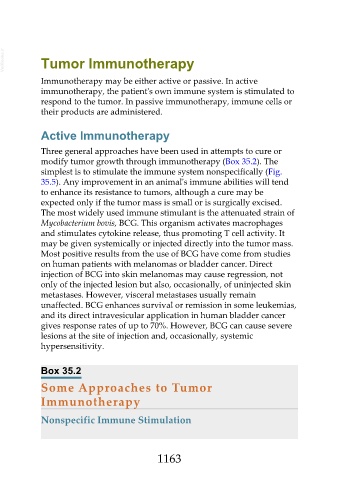Page 1163 - Veterinary Immunology, 10th Edition
P. 1163
VetBooks.ir Tumor Immunotherapy
Immunotherapy may be either active or passive. In active
immunotherapy, the patient's own immune system is stimulated to
respond to the tumor. In passive immunotherapy, immune cells or
their products are administered.
Active Immunotherapy
Three general approaches have been used in attempts to cure or
modify tumor growth through immunotherapy (Box 35.2). The
simplest is to stimulate the immune system nonspecifically (Fig.
35.5). Any improvement in an animal's immune abilities will tend
to enhance its resistance to tumors, although a cure may be
expected only if the tumor mass is small or is surgically excised.
The most widely used immune stimulant is the attenuated strain of
Mycobacterium bovis, BCG. This organism activates macrophages
and stimulates cytokine release, thus promoting T cell activity. It
may be given systemically or injected directly into the tumor mass.
Most positive results from the use of BCG have come from studies
on human patients with melanomas or bladder cancer. Direct
injection of BCG into skin melanomas may cause regression, not
only of the injected lesion but also, occasionally, of uninjected skin
metastases. However, visceral metastases usually remain
unaffected. BCG enhances survival or remission in some leukemias,
and its direct intravesicular application in human bladder cancer
gives response rates of up to 70%. However, BCG can cause severe
lesions at the site of injection and, occasionally, systemic
hypersensitivity.
Box 35.2
Some Approaches to Tumor
Immunotherapy
Nonspecific Immune Stimulation
1163

